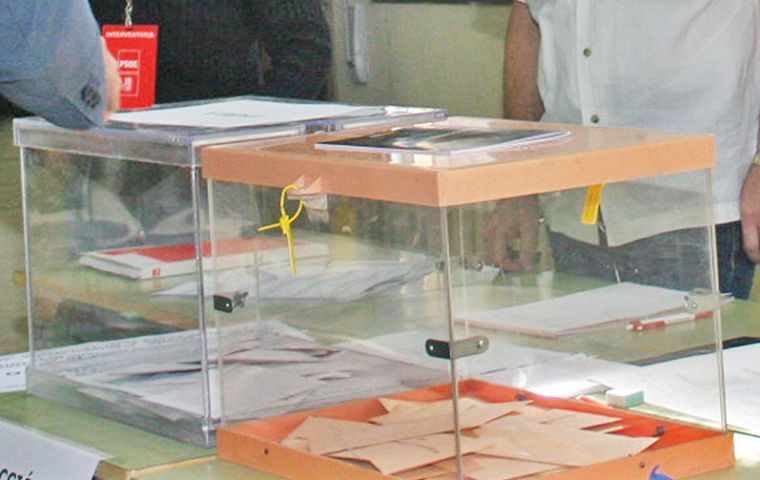MercoPress. South Atlantic News Agency
Chilean presidential candidates working together against voters' apathy
 In the first round abstention had more support than Bachelet and Matthei together
In the first round abstention had more support than Bachelet and Matthei together Voter turnout in Chile's extreme north and south fell far short of national average, and candidates will look further afield for votes in upcoming elections December 15. As Chile’s presidential candidates turn their heads to the country’s far-flung regions, a report by La Tercera demonstrates the particularly high rates of abstention in rural areas in both the extreme north and south.
In November’s parliamentary and first round presidential elections, 6,679,391 citizens out of a total 13,573,143 — or 12 million according to parties that contest the Electoral Service’s (Servel) accuracy — voted, only 50.8% of the population.
Michelle Bachelet, candidate for the left-leaning Nueva Mayoria electoral pact, won 46.7% of the first round of vote, comfortably beating Evelyn Matthei, the candidate for the conservative Alianza coalition. The latter will hope high rates of abstention, however, will present an opportunity to make ground come Dec.15’s second round vote.
The report shows that communities in Chile’s extreme north and south cast the lowest percentage of votes. Voter turnout was lowest in the region of Tarapacá — more than 1000 miles north of Santiago — with just 38.8% of its inhabitants voting.
The campaign teams of both candidates responded to the high rates of regional abstention, campaigning far away from Santiago over the weekend. Bachelet was in Antofagasta — where 41.7% voted in the first round elections — over the weekend encouraging people to vote.
“Of course in voluntary systems there will be high abstention, but what is also certain is that afterwards we cannot complain when we don’t like the outcome” she told press.
Regionalist Party of Independents (PRI) congressman Pedro Araya accompanied Bachelet as she took to the streets in the country’s far north.
“What we are trying to do at the moment is work more intensely on the street, with much more door-to-door conversation, above all in the more disadvantaged sectors,” Araya told The Santiago Times.
“Fundamentally, our work is focused on trying to knock on as many doors as possible of those who didn’t vote and explain to them the importance of voting.”
Matthei was also in Antofagasta over the weekend.
“We believe the next 15 days are crucial and as parties of the Alianza, in particular the [right-wing Independent Democratic Union (UDI)], we are going to do everything we can,” Patricio Melero, president of the UDI told Entorno Inteligente. “As you have seen in the city, we are unveiling a campaign that supports the candidate. We are going to travel to every region in the country.”
Increasing voter turnout is crucial not only for the results of the upcoming elections, but also for the credibility of the future president once elected, says Alfonso Donoso, political scientist at the Universidad Católica.
“When the number of voters that participate in an election is low, the legitimacy of whoever is elected to work in congress or as president is threatened because the low turnout calls into question their level of representation and citizen support,” he told The Santiago Times.
However, Eduardo Salas, General Secretary of the PRI, feels this kind of campaigning is useless.
“These are last minute steps,” he told The Santiago Times. “There are less than 15 days left, we are talking about something imminent and I don’t know if it’s going to have any effect. I think it is very likely the voting figures will stay the same or maybe even decrease from those see in the first round.”
One possible explanation for high rates of abstention is the economically-disadvantaged situation of many in these regions.
“We believe that fundamentally people with the fewest resources did not go and vote,” Araya told The Santiago Times. “If you look at the composition of the people that voted in Tarapacá and Antofagasta, they are mainly well-off economically.”
Anthony Pezzola, head of the masters program of political science at the Universidad Católica, expressed similar sentiments, but claimed other factors may also be at play.
“Another factor possibly explaining the lowest rates among similar neighborhoods could be the distance from home to the place of voting,” he told The Santiago Times.
In contrast, Carlos Larraín, president of the center-right National Renewal (RN) party, attributed low turnout to apathy.
“We must shake off this drowsiness, then the 25% that already voted can convince their neighbors [to vote], and we can win,” he told CNN. “Right now the problem is indifference.”
While the comparatively disadvantaged Tarapacá saw the lowest turnout in the country some of the highest participation was in the wealthy neighborhoods of eastern Santiago. Providencia had a turnout of 57% while Las Condes’ 61.6% was the highest in the country.
By Benjamin Druttman and Emily McHugh – The Santiago Times




Top Comments
Disclaimer & comment rulesCommenting for this story is now closed.
If you have a Facebook account, become a fan and comment on our Facebook Page!